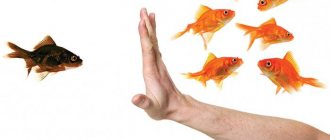Landmark, position, principles
A moral guideline is the goals and prohibitions (existing in the mind) that a person uses as a model for constructing a line of behavior.
Those. a moral guideline represents a clear framework beyond which a person does not allow himself to go.
Moral position is an assessment of the norms of social behavior and their compliance. A person passes this assessment through an internal “filter”, realizing it and accepting it as a guide for his own actions. Moral position includes:
- behavioral motives,
- self-regulation and control of one’s own actions,
- conscientiousness,
- a sense of human dignity (from the position of a person who has chosen a certain moral position for himself).
Moral principles are the framework on which social and interpersonal relationships are built.
At the same time, it is fair to assert that moral principles are universal, support social foundations through an external mechanism of influence (public approval or censure of behavior patterns), and can be expressed in moral norms.
Civic conscience
For the purpose of moral and civic education, the main objectives of this component of education are: the formation of a moral and civic conscience and the formation of moral and civic behavior.
It should be noted that this division between theoretical and practical tasks is made for didactic reasons, somewhat artificial, because the moral and civic profile of the subject develops simultaneously on both sides, accepting both information and action, feelings, beliefs, facts.
Human qualities: list
Morality and ethics intersect, forming a single system of qualities. This category includes the moral block:
- love for people
- respect for others,
- devotion (loyalty),
- selfless beginning (motivation to act due to good intentions rather than potential gain),
- spirituality (combination of morality and religiosity).
And the moral block :
- call of Duty,
- responsibility,
- honor,
- conscience,
- desire for justice
- dignity.
In addition to positive moral qualities, there are also negative ones : anger, envy, deceit, etc.
If the level of morality in a society is low, over time, negative actions and qualities become acceptable and preferable for society, and are then instilled in younger generations as the current norm.
The substitution of concepts occurs very quickly and the dynamics can be tracked even using the example of children and their parents.
A positive moral quality is recognized as such at the level of entire communities. And such universal qualities guarantee that their owner will be identified as a moral and educated person.
The most highly valued in modern society are responsibility, humanity, openness, sincerity, discipline, loyalty, collectivism, tact, hard work, diligence, and cleanliness.
High moral qualities are those qualities that are in the “positive” pole in a given society/culture.
But in some cases , “high” are those qualities that are dictated not so much by the need to successfully integrate into society, but by the deep and sincere feelings of an individual. This category includes patriotism, chastity, and absolute humanism.
Behavior
Behavior becomes moral when an individual ties it to the existing system of moral values and tries to bring his actions to positive guidelines.
The key element of moral behavior is action .
An act, in turn, consists of an action and can receive a positive or negative assessment from members of society.
Abstaining from any action at a time when morality requires a person to be active can also be regarded as an act.
Moral behavior is difficult to evaluate objectively, but others always pass other people’s actions through “filter factors” :
- motives (if a noble motive led a person to an unsightly result, the degree of indignation of society will decrease),
- the result of an action
- objective reality (the circumstances in which the act was committed),
- means of achieving the task (a person can use “forbidden techniques” on the way to a good goal, which will seriously darken his moral character).
Moral behavior is always an attempt to find a balance between the restrictions established by society (framework) and one's own freedom (creative choice).
What are the standards?
Moral standards can be represented as a scale with two poles , one of which displays encouraged behavior patterns, and the other condemned.
Moral norms can be divided into two types: about what is permissible and what is unacceptable (about good and evil).
The concepts are opposite and mutually exclusive, which means that each norm has its own antipode.
This forces a person to take a stable position, since it is impossible to maintain neutrality in conditions of polarity (unless inaction is a conscious choice of a person who is ready to be condemned by others).
External obstacles
The affective component provides the energetic substrate necessary for the conduct of moral and civic knowledge. The subject's emotions and feelings towards moral and civic commands emphasize that he not only accepts values, norms, moral and civil rules, but also lives and identifies with them. It follows that both moral standards of behavior in society and affective attachment are necessary for moral-civic interaction. However, they are not enough, because often when performing moral and civic actions there may be a number of external obstacles (temporary problems, unfavorable circumstances) or internal (interests, desires), for which efforts are required or, in other words, the intervention of the volitional component is required.
Relativism, what is it?
Moral relativism is a position whose proponents deny the possibility of the existence of absolute evil or good.
According to moral relativism, morality is not tied to universal standards.
Ethical behavior is only a variable value that changes as a result of changing scenery (culture, participants in the action, nuances of the situation, etc.).
Relativism can be viewed in two ways:
- the concepts of “good” and “evil” are conditional in themselves,
- public morality is conditional relative to unconditional standards of good and evil.
Briefly about the theory of moral development
How is morality formed in children? Many scientists have asked this question. But in the modern world, only Lawrence Kohlberg's theory has achieved wide recognition.
Kohlberg used the dilemma method. He projected onto children situations in which the young participants in the experiment had to make difficult moral choices.
As a result, the idea that children develop spontaneous morality, not tied to any numbers or indicators, was rejected.
Kohlberg identified three levels of development of moral consciousness:
- Age from 4 to 10 years. This level was called "pre-moral". In the period from four to ten years, a child puts his own benefit and safety at the forefront. At the first stage of development, he seeks to gain approval in order to escape punishment. And the correct tactics of behavior are easy to build with the help of tips (social norms). At the second stage, the child is already focused on potential rewards for good behavior. The kid thinks not about punishment, but about benefit.
- Age from 10 to 13 years. The level is called conventional. During this period, the child already begins to understand the rules and values accepted by society. At the first stage, the measure of moral success is people from one’s close circle. Shame and the reluctance to disappoint authority figures pushes people to follow the rules. At the second stage, the child already understands the reasons why the restrictions were introduced. He also sees them as a way to assert and protect his own rights.
- Age after 13 years. A teenager creates his own system of moral values, adjusting the template accepted by society.
At the first stage, a lot of attention is paid to those norms that help to survive and maintain peace in society. At the second stage, a person already has stable moral principles, which he adheres to despite external influences and circumstances. If necessary, the individual will be able to fight back and endure the disapproval of the crowd if the behavior of the crowd seems unfair.
– 74 –
A.V.Razin
Models of moral behavior
In this article I want to propose models of moral behavior, formulated in a formal logical sense, in order to show how different kinds of emotions work in moral motivation. I am aware that the behavior models proposed below will contain a certain simplification of the forms of behavior encountered in real life. Nevertheless, simplification is a means of any theoretical analysis. So in the approach to morality it is completely justified.
In the process of satisfying various needs of the body, we are faced with the following mechanisms of manifestation of emotional regulation: these are, firstly, emotion-stimuli that trigger behavior. They can be different in strength and sign. The state of dissatisfaction of some need is expressed in negative emotions, expressing some tension, melancholy, and disappointment. But the dominant one here is positive motivation, since it is this that determines desire. This initial motivation in the process of satisfying needs is superimposed with a new emotional impact from the emotions of controllers. They reflect the joy of satisfaction and dissatisfaction regarding the achievement of intermediate and final results. A high probability of satisfying a certain need increases the excitement from the anticipation of the imminent achievement of a result and thereby creates an enhanced emotional perception (positive) of the entire process of satisfying a certain need. But these emotions nevertheless cannot become relevant without some initial
– 75 –
emotions that trigger the entire system of activity. For example, the pangs of creativity, joy and grief create a specific background for this process, but they cannot take place without the initial desire for creativity, an ideal plan, activity, developing on the basis of an initial positive emotional attitude. In its immediate form, this scheme for satisfying various human needs is not related to moral behavior, although the indirect emotional influence of the process of satisfying higher social needs on moral values and vice versa cannot be excluded.
From our point of view, in those cases when the moral motive manifests itself most clearly, when it is not merged with other social motives of activity, it is not the internal need of the organism, but the external situation that serves as the stimulator of activity. For example, if a person rushes to save a drowning man, he does this not because he has previously experienced some emotional stress, similar to, say, hunger, but simply because he understands or subconsciously feels what subsequent life with the consciousness of an unfulfilled duty will represent for him. torment. This situation constitutes, in our opinion, the first sacrificial model of moral behavior
, farthest from the influence of positive emotional motivation. In fact, behavior here is based mainly on the desire to avoid strong negative emotions, including those that may even be an alternative to life itself. Let's say, a person does not commit treason, even knowing that he is going to certain death because he ideally imagines life with the consciousness of an unfulfilled duty as a continuous torment of conscience. Because of this, he consciously chooses death, although, of course, additional motives associated, for example, with hatred of the enemy and the desire for revenge are not excluded here. This, however, does not negate the model itself, which in theoretical abstraction appears precisely as behavior based on the desire to avoid strong negative emotions of a moral nature, to prevent pangs of conscience.
This model shows that not all human behavior is based on his needs, as many believe. In normative regulation there may be an independent motive associated with the fulfillment of a prescribed duty. In law, such a motive is implemented out of fear of the application of sanctions. In morality, it is associated with shame and conscience.
– 76 –
However, the need to perform such selfless acts is relatively rare. Revealing the essence of the moral motive, it is necessary to explain not only the fear of the torment of an unfulfilled duty or remorse, but also the positive direction of long-term activity of behavior, which inevitably manifests itself when it comes to one’s own good. It is clear that the justification for the need for such behavior is not carried out in some emergency circumstances and its determination requires not an episodic, but a long-term goal.
Here we can formulate the second model of moral behavior: moral motivation of a programmatic nature.
It is clear that a person makes general plans for his life. Sometimes he dreams of being famous, sometimes he wants to be content with the quiet happiness of family life and material wealth. But in any case, he is guided by certain criteria that show that living this way is better than living differently. Moral values form an essential part of these criteria.
Constantly receiving pleasures of the same quality (although they may be varied) does not lead to real happiness. This happens because the so-called law of emotional satiety is triggered. Emotions of the same type that accompany some activity initially cause joyful excitement from achieving intermediate results and make the entire process of the activity attractive. But gradually they begin to fade away. Physiologically, this is explained by the fact that the entire mechanism of activity becomes habitual. In fact, it no longer requires the concentration of significant resources of the body. But emotional arousal is essentially a way of attracting new resources to achieve some result. In this case, not wanting to lose the desired state of emotional arousal, a person can follow the path of quantitative diversity in the activities performed. For example, he can change boring clothes from time to time, buy new furniture, trying to create an interior that is more and more pleasing to the eye. This is how a consumer orientation of life arises, associated with the constant acquisition of more and more new things. But emotions still continue to fade, since the obstacles that a person overcomes when performing the same type of activity also turn out to be of the same type.
– 77 –
Fundamentally the same process is carried out in gaming activity. Some modern Western philosophical theories, for example philosophical anthropology (A. Gehlen, N. Fink), consider play the most desirable type of human activity, an activity that corresponds to the highest human manifestations. But in a game (unless it is a global sports competition, which is in fact no longer a game in the usual sense of the word), a person, wanting to avoid negative emotions, reduces the intensity of creativity. Thus, he experiences less strong positive emotions, as a result of which he receives less satisfaction than in real stressful life.
The unambiguous desire to obtain sensual pleasures as the goal of life was criticized in ancient Greek philosophy. So Plato, in the dialogue Philebus, criticizes the position according to which happiness lies in strong pleasures experienced only in the present. Through the lips of Socrates, he expresses the following thought: “... having acquired neither reason, nor memory, nor knowledge, nor correct opinion, you, being deprived of all understanding, of course, would not know, first of all, whether you are rejoicing or not rejoicing”[1]. Consequently, without reason, without the ability to compare pleasures, without the idea of time, it turns out that it is even impossible to understand whether you are in a state of pleasure or not. But ancient philosophy worked in solving this problem mainly in the direction of how to receive such pleasures that do not entail suffering, how to achieve peace and serenity of spirit. The understanding of freedom was associated with such a state, or more precisely, with its non-violation.
All subsequent development of Western philosophy shows the insufficiency of such poor definitions of freedom. In order to formulate positive ideas about freedom as freedom of creativity, freedom of personal self-expression, it turns out that it is necessary to have an external source of activity, a goal of activity external to the human consciousness.
Such a goal, showing the path of moral self-improvement, spiritual elevation, is clearly presented in Christian ethics through the idea of \u200b\u200bGodlikeness. With the help of asceticism, the fulfillment of the commandments, a person freely abandons his bad, sinful nature in order to acquire a new one - God-like. In scholasticism these ideas receive
– 78 –
certain philosophical elaboration. Thomas Aquinas introduces a new element into the Aristotelian understanding of contemplative activity. Bliss appears to him as the undisturbed contemplation of God. It includes an element of pleasure, but not as its own goal or motive for action, but as a result accompanying the knowledge of God. Thus, contemplation from a goal containing the criteria of good in itself turns into a means.
The production of pleasure from externally oriented activities corresponds surprisingly closely to some of the real conditions for achieving happiness noted by psychologists. According to S.L. Rubinstein, for example, happiness is achieved in the process of life, not specifically dedicated to the pursuit of it, precisely as a concomitant result [2]. Such a coincidence of religious Christian doctrine and secular understanding can hardly be accidental. It confirms the borrowing of analogues of the relationship between man and God from the conditions of earthly existence: the relationship of man with society, with other people, which determine the external guidelines of his activity.
But the ideal affirmed by Christianity, the opposition it allows between the lower (worldly) and the higher (divine), the uncertainty of the positive characteristics of the latter, still does not orient towards overactive, intense activity. Many features of this ideal turn out to be close to ancient contemplation. In modern interpretations of Christianity, for example in personalism (E. Mounier), neo-Thomism (J. Maritain), the abstract features of the Christian ideal are overcome by reviving in new versions the generally quite ancient idea of orthodox Christianity that a person is involved in the work of the deification of the entire cosmos, filling it with divine love, lost as a result of original sin. This recognizes the need for some external substrate of transformative activity, which is one of the conditions for human life to be filled with higher meaning.
In subjective idealistic concepts, despite the desire to limit the perception of the world to the scale of some individual consciousness, the need for an activity goal external to this consciousness itself is still recognized. Thus, for Fichte, the will generates the world in order to have an obstacle to its own movement. For Sartre, a person is simply
– 79 –
arbitrarily chooses some external significant goal of activity, again in order to have an obstacle, an object of application of the activity of consciousness. But this goal cannot be exclusively personal. In order to be convincing, large-scale, it must also be shared with other people. American pragmatism formulates this idea through the category of the universality of faith, which allows one to overcome doubts about the goals of individual existence.
So, for true happiness, a person needs some external goal of activity shared with other people. At the same time, this goal must be at the same time significant on a personal level. Otherwise, the activity will not be free, will not be perceived emotionally positively and, accordingly, will not be real creativity, since it is impossible to create under compulsion. Negative emotional motivation, resistance according to the general logic of the role that emotions play in the sense of preparing an individual for activity, does not contribute to the concentration of the body’s resources. How can both be combined if a person does not have an innate moral need, if he also does not have an initial desire for many complex types of social activities, which are necessarily mastered by the individual in the process of joining the social and cultural life of a certain society. It seems that the answer to the question posed lies in the awareness of the complex nature of human action, in which a number of different needs are simultaneously satisfied and motives of different orders are combined. Positive motivation is most of all introduced into a morally approved action from the process of satisfying all (non-moral) higher social needs of the individual. At the same time, moral motives can enhance emotions of a non-moral nature. This happens because a person sees in the moral criteria of society a confirmation of the real complexity, sometimes even the uniqueness of the problems he solves. For example, the moral factor of work, the consciousness of the social significance of what is being done, enhances creative emotions, as a result of which the process of creativity, oriented towards social values, becomes more attractive to the individual than a game, or, especially, antisocial behavior. Moral values, therefore, set those external goals of activity shared with other people, the achievement of which is a condition for true happiness.
– 80 –
When considering this model, it should be emphasized that man is a cultural and historical being. It does not have some unchangeable nature, given by the information carrier contained in itself. In the course of individual development, genetic factors, represented by the biological organization of the individual, cooperate with the cultural program of social development in such a way that most of the functional manifestations of personality simply cannot be realized without the influence of these cultural factors.
Those requirements that are implemented through the first and second models of moral behavior are not only restrictions prohibiting certain actions in relation to other people (in particular, the prohibition of using another as a means, the prohibition of committing unfair actions against him), and not only the expression the optimal way to satisfy desires, allowing to avoid suffering. In a global sense, due expresses the historically developed cultural nature, which is necessarily prescribed to each individual entering public life. Since the formation of many higher human qualities, including the mastery of historically developed labor skills, the development of spiritual culture, education, requires effort, it is prescribed to each individual as a requirement, as a matter of course. The highest qualities associated with human cultural activity are therefore opposed to some simple desires, which can easily become the dominant of the developing consciousness and close the way to the formation of new abilities and the higher social needs corresponding to them. The task of overcoming the attractiveness of primary desires often leads to declaring them shameful or sinful. But even if you do not use this religious terminology, the contradiction between activities that are personally attractive, but undesirable for social development, and other qualities that must be formed by overcoming or partially repressing the former, still remains relevant. Its resolution is necessarily expressed in the idea of moral improvement, which is associated with the historically specific ideal of a perfect personality.
– 81 –
But this does not mean that a person exists under constant pressure from social demands. By developing new types of social activity, he overcomes obstacles, experiences corresponding emotions of joy, and develops new abilities, the implementation of which again leads to new positive emotional states. As a result, what was presented to a person as his due, ultimately turns out to be his own good. In fact, social demands express objective (confirmed as a result of processes of spiritual and practical reflection) good, which a person, in contrast to the common idea of freedom of moral choice, does not choose. He simply doesn't have that choice. The program of social development of an individual is given to him informationally as good through the demands of society. The field of moral choice unfolds in the zone of searching for the optimal path to good. In Christianity, this is reflected in the idea that only goodness has ontological reality. Evil represents only a deviation from good, which is the greater the greater the deviation. This understanding fundamentally coincides with the secular point of view. Good is indeed more substantial than evil, since in the most general sense, good is creation, the creation of new material and spiritual forms of being, while evil represents the destruction of these forms.
The third model of moral behavior can be defined as compassion.
Compassion as the basis of moral behavior was decisive in the concepts of D. Hume, P. Kropotkin, A. Schopenhauer. The latter saw in compassion the starting cell, the basis of morality, from which all other moral relations are derived. I believe that this model operates along with others as a relatively independent basis for a certain range of moral relations. The essence of compassion, therefore, is that by showing pity for another, a person actually indirectly feels sorry for himself, suggesting that it is possible that he is in the same situation as the person who is actually affected by the attitude of compassion. It is important to add to this that such placement is carried out not only due to the capabilities of a person’s consciousness, but even more due to the work of the unconscious layers of his psyche. This is due to a special way of orienting creatures with a psyche in space, i.e. with orientation based on an ideal image[3].
– 82 –
When orienting on the basis of an ideal image (orientation based on direct connections), the situation of a future action is played out in the field of brain signals. As a result, it becomes possible to give signals of different strengths to the muscles, i.e. signals that correspond to the specific position of the subject in space and the result that he seeks to achieve. For example, in order to make a successful jump on a victim, you need to estimate the distance (which is different in different cases) and the possible direction of the victim’s movement. This assessment is made on the basis of an ideal model in which all real relationships are not simply reflected, but are actually played out in brain signals in relation to a point in time in the future. To create such a model, it is necessary to first interpret space and time from the point of view of their objective properties, as well as create a system of ideas about one’s own possibilities of action in space and time. This interpretation, in fact, involves the elaboration of hypothetical situations of being in different points of space, from which follows the involuntary placement of oneself in the situation of another. Thus, overcoming their own subjectivity in the name of successful orientation in non-standard situations of action, beings endowed with the psyche, to a certain extent, overcome their egoism.
To a certain extent, higher animals are capable of this. The reaction of compassion can manifest itself in them when it is not supplanted by another dominant, for example, a dominant for successful hunting. Modern literature describes many examples of the manifestation of emotional resonance on the part of animals in relation to humans. For example, a dog becomes closer to a crying child. The emotional reaction of pity also manifests itself between the animals themselves. Let's say baby seals cry when they see their mother die. All this suggests that at least the higher animals cannot be excluded from our mutual moral relations. Animals that do not have a psyche can unilaterally become the object of our moral relations, since due to their similar organization to us, we still feel sorry for killing them and causing them suffering, although they themselves are incapable of empathizing with others.
Thanks to conceptual thinking, a person has great opportunities to clarify the situation in which another is located. It would seem that this should automatically follow
– 83 –
strong reaction of compassion. However, this often does not happen due to the same ability to think in concepts. Since conceptual thinking presupposes a distinction between analysis and action, emotions (it is they that push us to action) are necessarily muted in the thinking process. Moreover, they, especially when it comes to compassion, can be consciously repressed due to the fact that the pragmatic goals of existence often require the use of another as a means for one’s own successful existence. This shows the initial duality of the basis of a person’s moral attitude towards another, which is both affirmed and eliminated due to the developed abilities of brain activity. And only a long historical experience of self-reflection ultimately allows him to come to the conclusion that action, in contrast to the natural reaction of compassion, appears as violence against one’s own nature, as a contradiction in the work of consciousness and subconscious.
The next model of moral behavior can be presented as charity, philanthropy
.
In emotional terms, the mechanism for implementing this model of moral behavior is associated with the fact that a person tries to avoid those negative emotions that are generated as a result of the ability of compassion. From here he tries to improve the situation of another, which can be expressed in a separate act of help or take a more general nature when such activity is encouraged by society, when special social institutions are created for this purpose. For some people, working in such institutions can become the meaning of their life. In this case, this model appears in their behavior in a form mixed with the second model.
Further, the basis of moral behavior can be general ideas about justice, developed not only on the basis of moral, but also on the basis of political consciousness. This allows us to talk about the fifth model of moral behavior, which can be called the model of justice.
.
Emotionally, moral behavior based on the idea of justice is associated primarily with negative emotions that arise when justice is violated (outrage at unjust actions or unjust social orders).
– 84 –
The relationships of people to each other are reflected in the concept of justice in connection with their belonging to a certain whole. Without understanding the meaning of preserving this whole in the interests of everyone, assessing individual moral actions as fair or unfair loses its meaning.
The derivativeness of the idea of justice from the idea that it is necessary to ensure the stability of some whole, that without this it is impossible to preserve the conditions of one’s own existence, is confirmed by the primitive beliefs of ancient man. “The first germ of a generalization in nature, so vague that it hardly differed from a simple impression,” says Kropotkin, “should have been that a living being and its tribe are not separated from each other.”[4] This generalizing logic of thinking leads to the emergence of the idea of justice. It is associated with the desire to restore the harmony of the whole that has been disrupted due to wrong actions. Primitive savages and more civilized peoples to this day understand by the words “truth” and “justice” the restoration of a disturbed balance[5].
More developed ideas of justice require, however, not just to reproduce the idea of maintaining equality, but also to reflect the individual contribution of everyone to the production of social wealth. In this regard, Aristotle already very insightfully distinguished between distributive and egalitarian (directive) justice.
Directive law actually means that an equivalent exchange of moral qualities is observed, that rules that are the same for everyone must be followed by everyone. This constitutes the content of directive law (affirming an equal attitude to the law) and directive justice, which evaluates such a state as positive and necessary. “After all, it makes no difference who stole from whom - a good one from a bad one or a bad one from a good one - and who committed fornication - a good one or a bad one; but if one acts unjustly, and the other suffers injustice, and one caused harm, and the other was harmed, then the law takes into account the difference only from the point of view of harm, but it treats people as equals.”[6].
Distributive justice takes into account individual merit and implies a greater reward for greater merit. “...Distributive law, with which everyone agrees, must take into account a certain dignity”[7]. Therefore, in
– 85 –
This type of law takes into account what individual contribution this or that person makes to the development of the good of a certain whole. This is the basis for determining what part of the social wealth he can enjoy unequally with others.
As the individualization of the individual is recognized as a greater and greater value, the ideas of justice also reflect the conditions of personal existence necessary for individual self-expression. In this regard, society itself is assessed from the point of view of how much it protects individual rights and how much it provides the opportunity for self-realization of each person. However, the possibility of self-realization for everyone is always correlated in the concept of justice and with the interests of all, with the original idea of maintaining integrity and increasing the wealth that belongs to everyone. Because of this, the category of justice shows to what extent individualization is permissible. The transformation of the satisfaction of personal interest into the only criterion for the orientation of behavior is always assessed in the moral consciousness as unfair, as selfishness. Such an assessment causes corresponding negative emotions, which form the basis of a sense of justice. As for positive emotions, they, of course, can arise regarding the restoration of violated justice. But unlike satisfying ordinary human needs, these emotions are not the initial stimuli of behavior here. The starting point is the external situation associated with the violation of justice and indignation about it. A person cannot consciously strive to restore violated justice as a permanent moral goal (even if this is his profession, for example, a human rights activist, lawyer), since such a desire indirectly implies his interest in ensuring that justice is constantly violated. This cannot be a moral goal. Thus, in the case of the model of moral behavior associated with a sense of justice, we are dealing with independent motives that manifest themselves in connection with the fulfillment and violation of moral requirements, and not in connection with any special human needs.
The last, sixth, model of moral behavior is reverence and heroism
.
– 86 –
The relationship of an individual person to the whole, i.e. to the society in which he lives, to the cultural environment of his habitat, can be expressed in a special sublime sense of belonging. In religious consciousness, such a feeling is usually characterized as a feeling of reverence. By its nature it represents a highly developed consciousness of respect and gratitude. But this feeling does not arise on its own. It, like other human social feelings (for example, shame), is cultivated by specific means of moral influence. The virtue of piety was associated with the formation of a sense of reverence in traditional moral systems. The presence of virtue indicates that possessing a sense of reverence is prescribed to a person as a duty. The nature of the feeling of reverence from the point of view of human emotions represents the fear of the gods, transformed into a feeling of peace associated with the fact that all due duties (gratitude, obedience, sacrifice) are performed normally. Thus, in the manifestation of this moral feeling, we are faced with the action of emotions of a positive and negative nature, with negative emotions being primary. In a culture built on secular ideals, the virtue of piety loses its role, but any culture still develops symbolism and forms traditions that make a person feel involved in the whole. For example, there are military traditions of raising the flag and honoring the banner of the unit. In ordinary life, functions that develop feelings similar to the feeling of reverence are performed by the preservation of museum values. One way or another, people experience a certain awe when observing objects that were used by great scientists, writers, composers, although they may be the most ordinary objects constantly encountered in everyday life. Desecration of shrines makes a person want to protect them. From here a special kind of heroic action is born, in which a person most directly identifies himself with the whole. In contrast to heroism, which can manifest itself on the basis of the mechanism discussed in the first model of behavior (not giving secrets to the enemy), and seems to be forced heroism, positive motivation is manifested in behavior focused on preserving the shrine. But this motivation itself is associated with a long process of formation of new social feelings of a person, in which
– 87 –
submission to what should be, overcoming oneself, and therefore motivation of a negative nature, is primary. In some cases, heroic behavior can appear in a form mixed with the second model of behavior, that is, in terms of heroism as a constant process of satisfying higher social needs associated with the desire for prestige and glory. This is observed in special professions associated with constant risk, which gives the emotions associated with creativity the highest degree of tension.
Having analyzed these behavior patterns, we sought to show that a person does not have any universal moral sense. In each specific case of behavior, emotions of a positive and negative sign are manifested in their own way. The dominant role is played by emotions of a negative sign, representing a reaction to a possible or real violation of moral requirements. This, by the way, explains the fact that most codified moral norms have the character of a negative prohibition (do not commit adultery, do not use another as a means, do not lie, etc.). As for positive motivation, it, as already mentioned, most of all contributes to the process of perceiving the moral goals of life from the side of enhancing the positive emotional perception of the process of satisfying all the highest social needs of a person.
Notes
[1] Plato
.
Philebus // Plato
. Collection cit.: In 4 vols. T. 3. M., 1994. P. 19.
[2] See: Rubinshtein S.L.
Problems of general psychology. M., 1973. P. 369.
[3] See our articles about this in more detail: Consciousness and morality: anthropological unity // Bulletin of Moscow State University. Ser. 7. Philosophy. 1999. No. 3; The origins of moral self-awareness. Common sense // Ibid. 1999. No. 12.
[4] Kropotkin P.A.
Ethics. M., 1991. P. 59.
[5] See: ibid. P. 75.
[6] Aristotle
.
Nicomachean Ethics // Aristotle
. Works: In 4 vols. T. 4. M., 1984. P. 153.
[7] Ibid. P. 151.










